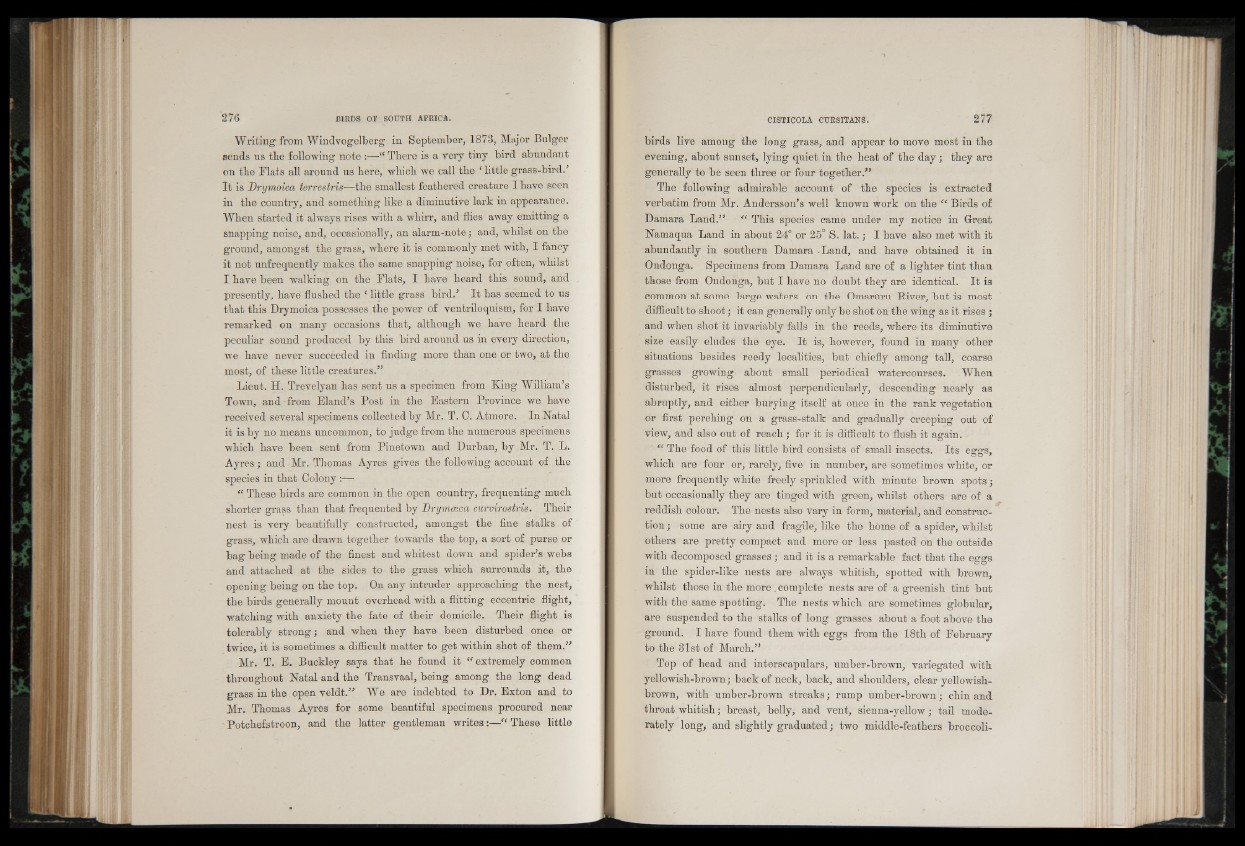
Writing from Windvogelberg in September, 1873, Major Bulger
sends us the following note :—“ There is a very tiny bird abundant
on the Flats all around us here, which we call the ‘ little grass-bird.’
It is Drymoica terrestris—the smallest feathered creature I have seen
in the country, and something like a diminutive lark in appearance.
When started it always rises with a whirr, and flies away emitting a
snapping noise, and, occasionally, an alarm-note; and, whilst on the
ground, amongst the grass, where it is commonly met with, I fancy
it not unfrequently makes the same snapping noise, for often, whilst
I have been walking on the Flats, I have heard this sound, and
presently, have flushed the 1 little grass bird/ It has seemed to us
that this Drymoica possesses the power of ventriloquism, for I have
remarked on many occasions that, although we have heard the
peculiar sound produced by this bird around us in every direction,
we have never succeeded in finding more than one or two, at the
most, of these little creatures.”
Lieut. H. Trevelyan has sent us a specimen from King William’s
Town, and-from Eland’s Post in the Eastern Province we have
received several specimens collected by Mr. T. C. Atmore. In Natal
it is by no means uncommon, to judge from the numerous specimens
which have been sent from Pinetown and Durban, by Mr. T. L.
Ayres; and Mr. Thomas Ayres gives the following account of the
species in that Colony :—
“ These birds are common in the open country, frequenting much
shorter grass than that frequented by Drymceca curvirostris. Their
nest is very beautifully constructed, amongst the fine stalks of
grass, which are drawn together towards the top, a sort of purse or
bag being made of the finest and whitest down and spider’s webs
and attached at the sides to the grass which surrounds it, the
opening being on the top. On any intruder approaching the nest,
the birds generally mount overhead with a flitting eccentric flight,
watching with anxiety the fate of their domicile. Their flight is
tolerably strong; and when they have been disturbed once or
twice, it is sometimes a difficult matter to get within shot of them.”
Mr. T. E. Buckley says that he found it “ extremely common
throughout Natal and the Transvaal, being among the long dead
grass in the open veldt.” We are indebted to Dr. Exton and to
Mr. Thomas Ayres for some beautiful specimens procured near
Potchefstroon, and the latter gentleman writes:—“ These little
birds live among the long grass, and appear to move most in the
evening, about sunset, lying quiet in the heat of the day; they are
generally to be seen three or four together.”
The following admirable account of the species is extracted
verbatim from Mr. Andersson’s well known work on the “ Birds of
Damara Land.” “ This species came under my notice in Great
Namaqua Land in about 24° or 25° S. la t.; I have also met with it
abundantly in southern Damara .Land, and have obtained it in
Ondonga, Specimens from Damara Land are of a lighter tint than
those from Ondonga, but I have no doubt they are identical. It is
common at some large waters on the Omarüru River, but is most
difficult to shoot; it can generally only be shot on the wing as it rises ;
and when shot it invai’iably falls in the reeds, where its diminutive
size easily eludes the eye. It is, however, found in many other
situations besides reedy localities, but chiefly among tall, coarse
grasses growing about small periodical watercourses. When
disturbed, it rises almost perpendicularly, descending nearly as
abruptly, and either burying itself at once in the rank vegetation
or first perching on a grass-stalk and gradually creeping out of
view, and also out of reach ; for it is difficult to flush it again. 1
“ The food of this little bird consists of small insects. Its eeOrgo 's*,
which are four or, rarely, five in number, are sometimes white, or
more frequently white freely sprinkled with minute brown spots;
but occasionally they are tinged with green, whilst others are of a
reddish colour. The nests also vary in form, material, and construction
; some are airy and fragile, like the home of a spider, whilst
others are pretty compact and more or less pasted on the outside
with decomposed grasses; and it is a remarkable fact that the eggs
in the spider-like nests are always whitish, spotted with brown,
whilst those in the more . complete nests are of a greenish tint but
with the same spotting. The nests which are sometimes globular,
are suspended to the stalks of long grasses about a foot above the
ground. I have found them with eggs from the 18th of February
to the 31st of March.”
Top of head and interscapulars, umber-brown, variegated with
yellowish-brown; back of neck, back, and shoulders, clear yellowish-
brown, with umber-brown streaks; rump umber-brown; chin and
throat whitish; breast, belly, and vent, sienna-yellow; tail moderately
long, and slightly graduated; two middle-feathers broccoli